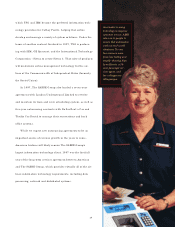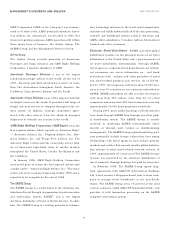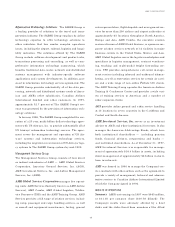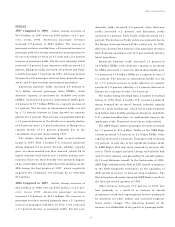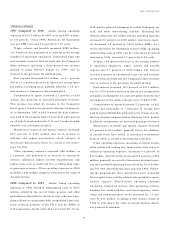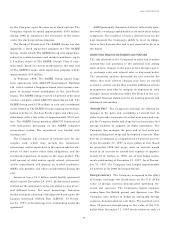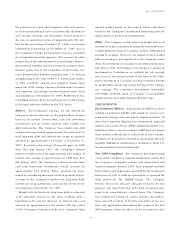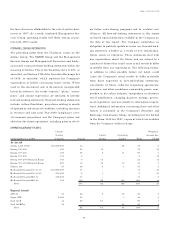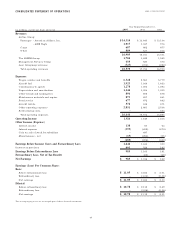American Airlines 1997 Annual Report Download - page 39
Download and view the complete annual report
Please find page 39 of the 1997 American Airlines annual report below. You can navigate through the pages in the report by either clicking on the pages listed below, or by using the keyword search tool below to find specific information within the annual report.
AMR CORPORATION
37
REVENUES
1997 Compared to 1996 Airline Group revenues of
$16.9 billion in 1997 were up $692 million, or 4.3 per-
cent, versus 1996. American’s passenger revenues
increased 4.9 percent, or $665 million. The increase in
passenger revenues resulted from a 2.6 percent increase in
passenger yield (the average amount one passenger pays to
fly one mile) from 13.03 to 13.37 cents and a 2.2 percent
increase in passenger traffic. For the year, domestic yields
increased 1.8 percent, Latin American yields increased 4.5
percent, European yields increased 3.8 percent and Pacif-
ic yields increased 1.0 percent. In 1997, American derived
69 percent of its passenger revenues from domestic oper-
ations and 31 percent from international operations.
American’s domestic traffic increased 2.0 percent to
74.3 billion revenue passenger miles (RPMs), while
domestic capacity, as measured by available seat miles
(ASMs), increased 0.8 percent. International traffic grew
2.6 percent to 32.7 billion RPMs on a capacity increase of
0.4 percent. The increase in international traffic was led
by a 7.2 percent increase in Latin America on capacity
growth of 5.5 percent. This increase was partially offset by
a 1.7 percent decrease in the Pacific on a capacity decline
of 2.9 percent and a 1.5 percent decrease in Europe on a
capacity decline of 5.3 percent, primarily due to the
cancellation of several routes during 1997.
The Airline Group benefited from several external
factors in 1997. First, a healthy U.S. economy produced
strong demand for air travel. Second, industry capacity
grew at a more modest rate than demand, which led to
higher industry load factors and a healthy pricing envi-
ronment. However, these benefits were adversely impact-
ed by a brief strike and the strike threat by members of the
APA during the first quarter of 1997, which negatively
impacted the Company’s net earnings by an estimated
$70 million.
1996 Compared to 1995 Airline Group revenues of
$16.2 billion in 1996 were up $710 million, or 4.6 per-
cent, versus 1995. American’s passenger revenues
increased 3.9 percent, or $511 million. The increase in
passenger revenues resulted primarily from a 2.1 percent
increase in passenger yield from 12.76 to 13.03 cents and
a 1.7 percent increase in passenger traffic. For the year,
domestic yields increased 2.6 percent, Latin American
yields increased 0.2 percent and European yields
increased 3.1 percent, while Pacific yields decreased 10.5
percent. The decline in Pacific yields was primarily due to
the foreign exchange impact of the weaker yen. In 1996,
American derived 69.6 percent of its passenger revenues
from domestic operations and 30.4 percent from interna-
tional operations.
American’s domestic traffic increased 2.3 percent to
72.9 billion RPMs, while domestic capacity, as measured
by ASMs, decreased 1.7 percent. International traffic grew
0.4 percent to 31.8 billion RPMs on a capacity decline of
1.2 percent. The increase in international traffic was led
by a 5.0 percent increase in Latin America on capacity
growth of 3.9 percent, offset by a 3.9 percent decrease in
Europe on a capacity decline of 6.4 percent.
The Airline Group benefited from a number of external
factors in 1996. First, a healthy U.S. economy produced
strong demand for air travel. Second, industry capacity
grew at a more modest rate, which led to higher industry
load factors and a healthy pricing environment. And third,
U.S. carriers benefited from an eight-month lapse in the
application of the 10 percent excise tax on airline tickets.
The AMR Eagle carriers’ passenger revenues increased
by 7.3 percent or $71 million. Traffic on the AMR Eagle
carriers increased 3.9 percent to 2.6 billion RPMs, while
capacity decreased 1.3 percent. Passenger yield increased
3.2 percent, in part due to the significant changes made
to AMR Eagle’s fleet and route network to increase effi-
ciency. These changes included closing its Nashville hub
and 33 other stations, and grounding 54 aircraft, primar-
ily 19-seat Jetstream aircraft. In the first quarter of 1995,
AMR Eagle redeployed its fleet of ATR aircraft in response
to the FAA’s temporary restrictions on the operation of
ATR aircraft in known or forecast icing conditions. The
fleet disruption adversely impacted AMR Eagle’s results in
the first and second quarters of 1995.
Other revenues increased 17.2 percent, or $123 mil-
lion, primarily as a result of an increase in aircraft
maintenance work and airport ground services performed
by American for other airlines and increased employee
travel service charges. The remaining portion of the
increase was attributable to the growth in passenger traffic.




